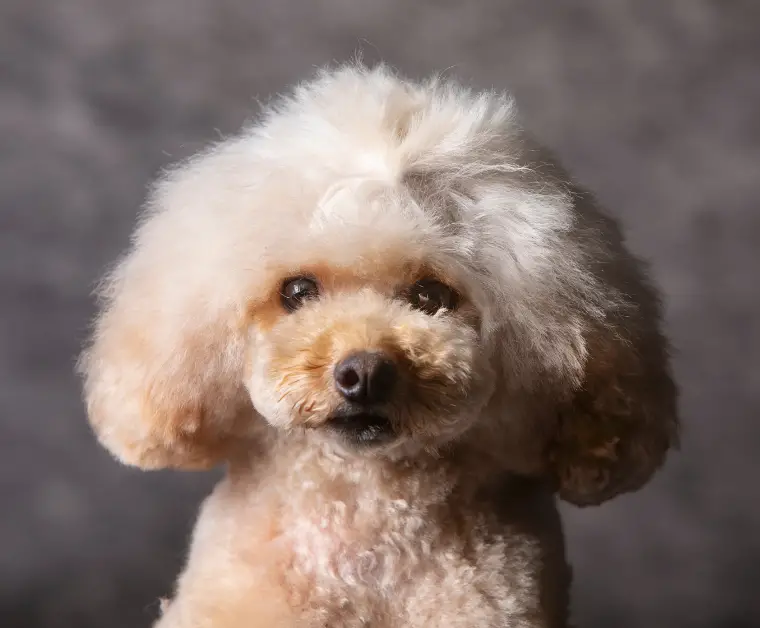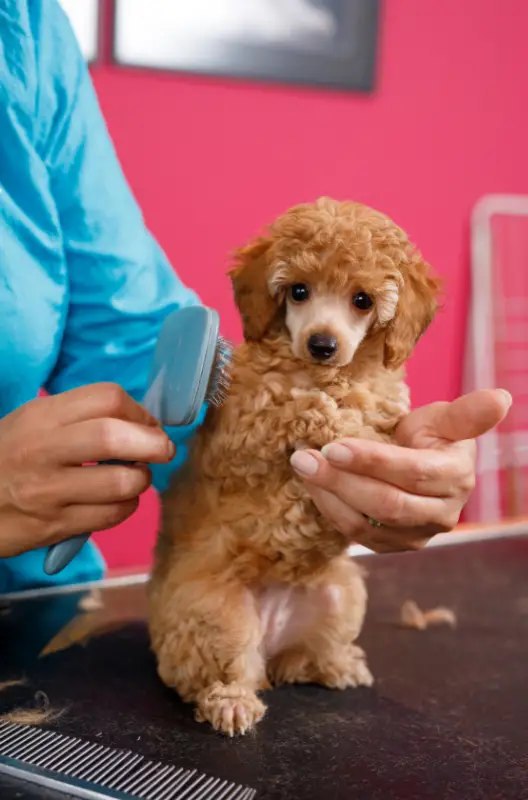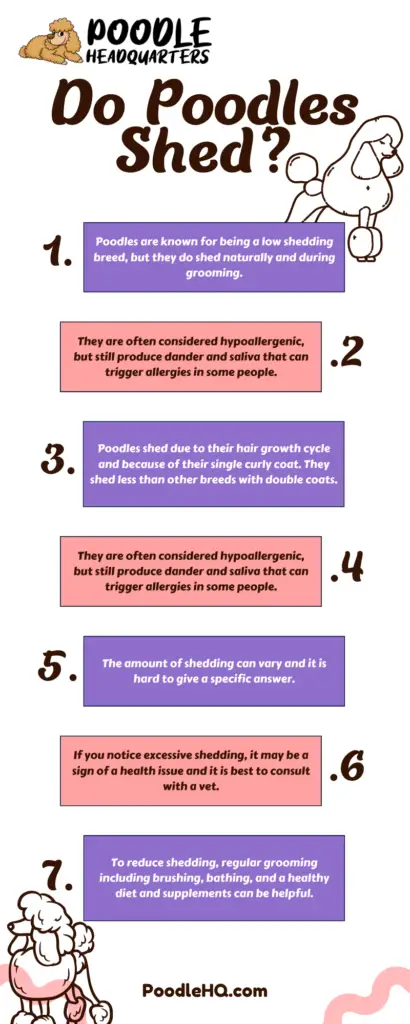Poodles do shed, but less frequently than other dog breeds. They tend to have a reputation as a low shedding breed. But, if you own a Poodle or planning to own one, do expect some natural shedding and during grooming. Don’t worry, though this is totally normal and occurs in all dog breeds.

What Will You Learn? 👇
Are Poodles Hypoallergenic dog breed?
Poodles are often thought of as hypoallergenic dogs because they do not shed as much as other breeds. However, this does not mean that they are completely hypoallergenic. Poodles still produce dander and saliva, which can trigger allergies in some people. If you are considering getting a poodle, it is important to spend time around the breed to see if you have any reaction to them before making a commitment.
Do you have Allergies to Dogs?
Yes, people can have allergies to dogs. The proteins that cause these allergies are found in a dog’s saliva and dander (dead skin cells). When a person with allergies comes in contact with these proteins, they may have symptoms such as sneezing, runny nose, itchy eyes, and difficulty breathing.

Read our Smart Poodles - Smart Tricks eBook for only $2.99
Dive into a treasure trove of engaging tricks and tips designed specifically for your poodle!
why is my poodle shedding?
To know the reason why Poodles shed, lets look at dogs as a whole. Dogs are mammals, and all mammals at some point have to shed hair. Think about it; we’re mammals too! Have you noticed when you’ve washed or brushed your hair that it’s fell out? Perhaps as you grew older from a child to an adult. Whenever it was, I know you must have seen your hair fall out at some point.
Besides the rest of the mammal family, dogs tend to shed because of the cycle. All hair undergoes something called a growth cycle, which typically is the following phases:
- Anagen (Growth phase) – Hair follicle gets nourished due to blood supply and starts to grow.
- Catagen (Transition Phase) – Hair follicle begins to detach from the blood supply.
- Telogen (Resting phase) – The lack of nourishment causes the hair follicle to fall out.
It’s in the telogen, i.e., the last phase known as resting, when a dog’s hair sheds.
We know by now why Poodles shed; it’s due to their hair growth cycle. Their hair typically grows to a specific length before it’s replaced. Most of the time, though, due to their curly coat, the hair will become trapped in there as opposed to on the floor, clothes, or furniture.
This means you will most likely retrieve their hairs from brushing them instead of picking them up in the home. While this can be beneficial, it’s essential you give them proper grooming to make sure their coat is healthy.
But have you ever wondered why they shed less than other dogs?
Well, those other breeds that tend to shed a lot have a double coat. At the same time, a Poodles coat is a single coat and is curly.
The double coat works as a protective layer allowing dogs to keep warm in the winter season and also keeps cool in summer. So, in addition to the year-round shedding, double-coated breeds experience heavy shedding at all times of the year. Poodles don’t experience this.
When do poodles shed?

Poodles are one of the lowest shedding breeds in the world due to their single coat. This also means they’re a hypoallergenic breed, as they shed very little. This is great if you’re someone who suffers from many allergies as they may not trigger them as much! However, some Poodle mixes aren’t hypoallergenic. If you have allergies, it is best to consult with your doctor before adopting any type of dog.
How much and how often?
When asking how much a Poodle can shed, it’s often like asking the question… how long is a piece of string? The answer is completely subjective and can depend on the dog and also what you notice as a dog owner.
Most of the time, Poodles will only shed a few strands of hair. However, what you notice, may be different from this, and that’s ok. The same applies to the frequency of their shedding. It’s believed that the average dog sheds every 3-4 days, whereas a Poodle can shed every couple of weeks.
What if you are noticing excessive shedding?
I mentioned earlier that Poodles shed very little as they have a longer hair cycle, single coat, and have hair instead of fur. But, what about when they shed too much?
Sometimes as a Poodle owner, you may notice Poodles shedding more than normal. This often can be a cause of concern and be concerning underlying health issues like skin infections, hormonal imbalances, nutritional deficiencies, inflammatory diseases, or interactions with certain medications they’re taking.
Typical examples of this are:
- Allergies: Depending on the type of dog shampoo you use when washing a Poodle, they may have an allergic reaction. Similarly, if they’re exposed to toxic chemicals, commercial dog food additives, and any other bad substances, their skin may become inflamed, they may scratch more, and hair will fall out.
- Sebaceous Adenitis: A skin disease that causes the skin’s sebaceous glands to become inflamed. As a result, the Poodles coat thins out or completely falls out altogether.
- Red Mange: This is where a cigar-shaped mite can live in a Poodles coat and bite the skin. If this happens, they will most likely have an allergic reaction and loose patches of hair.
- Castration responsive Dermatosis: This is a form of hair loss that is common in young male Poodles. It normally occurs in the groin and then causes them to lose it all over their body.
What you’ve just read are a few examples of medical conditions where a Poodle might shed more frequently. Alongside these, there are many more out there which can trigger this. If you own a Poodle and notice unusual amounts of shedding, then you should take it to a vet immediately. It could be a sign of an underlying medical condition.
when do poodles lose their puppy coat?

The unique thing about Poodle puppies is that even though their coat is different from their adult coat, they don’t tend to shed. Instead, their coat tends to grow and overgrow until they become an adult. During this phase, you must take your Poodle for haircuts as their coat could become matted easily. Generally, the transition period from a puppy coat to an adult coat is between 8-12 months. Also, some owners start shaving their face at a very early age, so you might want to consider that as well.
How to reduce shedding by grooming your poodle
It wouldn’t be fair on you to take the time to read this article about shedding if I didn’t give you some tips on how to manage your Poodles coat. To help you, read on below.
Brushing
To keep control of any mats, dead hair, or tangles, it’s best you brush your Poodle 2-3 times a week. This will keep their coat healthy and also increase blood circulation to the follicle. If you’re bad at keeping records when to brush them, you might want to stick to a schedule. Similarly, you should brush them while young so they become familiar with the grooming experience.
Bathing
You should bathe a Poodle once a month to keep their coat in good condition. You should use a dog-friendly shampoo and use a coat conditioner. It’s essential you use a conditioner as this will help their coat stay curly and smooth.
Diet
You must ensure your Poodle is getting the right balance of protein, vitamins, and nutrients in its diet. Similarly, make sure it’s fed high-quality foods that don’t give them any allergies, which could trigger shedding. To know what your Poodle can handle and is healthy for them, speak to a veterinarian for advice on feeding them.
Supplements
Flax seeds and Omega-3 fatty acids are great supplements that can help the Poodles coat. If they struggle with supplements, try giving them fish, and you’ll notice a difference.

Conclusion
Poodles are a remarkable breed, and I’m not even talking about the number of mixes out there! They’re highly smart, loveable, gentle, and gorgeous to look at. When I say good-looking, I mean they’re stunning smooth curly coats.
Even better, they’re one of the lowest shedding dog breeds out there. Plus, they’re hypoallergenic, which means they shed little and are great for people with allergies. If you do notice excessive shedding with a Poodle, it may be due to an underlying health condition. Now and again, it’s always good to take them to a vet and a professional groomer for their expert opinion.
Their low shedding abilities are one of the best factors about the Poodle, alongside many other qualities. What is your favorite Poodle quality or characteristic? Let us know in the comments down below.
Marko is the founder and author at PoodleHQ, where he blends profound expertise with formal training in Animal Behavior and Canine Genetics. With multiple generations of poodles under his care, he’s a breed connoisseur, honored with the Canine Care Excellence Award and lauded by the International Pet Enthusiasts Association.

